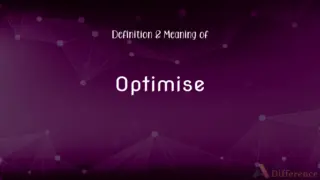Elephant Ear vs. Funnel Cake — What's the Difference?
By Maham Liaqat & Fiza Rafique — Published on December 13, 2024
Elephant Ear is a large, flat, fried dough pastry, often coated with cinnamon sugar, while Funnel Cake is made by pouring batter through a funnel into hot oil, creating a lace-like pattern, typically topped with powdered sugar.

Difference Between Elephant Ear and Funnel Cake
Table of Contents
ADVERTISEMENT
Key Differences
Elephant Ears, also known as palmiers in some regions, are made from a flattened dough that is fried until it puffs up and becomes crispy. This pastry is typically large, resembling the shape of an elephant's ear, and is often finished with a coating of cinnamon sugar or other sweet toppings. Funnel Cakes, on the other hand, are made by drizzling batter through a funnel into hot oil, which cooks the batter in a distinctive swirling, web-like pattern. They are traditionally served warm with a generous dusting of powdered sugar on top.
The origin of Elephant Ears is somewhat varied, with similar versions found in different cuisines around the world. They are a staple at many fairs, carnivals, and outdoor events in the United States. Funnel Cakes also have a rich history, with roots traced back to medieval Arabic and Persian cuisine, eventually becoming a popular treat in European and American fairs and festivals.
In terms of preparation, Elephant Ears start with a dough that is either yeast-raised or made from a simpler, unleavened mixture. The dough is rolled out into thin, large rounds and then fried. Funnel Cakes, however, use a liquid batter, which is poured through a funnel into hot oil, creating intricate patterns as it fries.
When it comes to taste and texture, Elephant Ears offer a chewy interior with a slightly crispy exterior, accentuated by the sweet and spicy flavors of the toppings. Funnel Cakes have a lighter, airier texture with a crispy exterior, and the powdered sugar adds a melt-in-your-mouth sweetness.
Choosing between an Elephant Ear and a Funnel Cake often comes down to personal preference for texture and sweetness level. Both are beloved fair and carnival treats, each offering a unique taste and experience.
ADVERTISEMENT
Comparison Chart
Base Ingredient
Flattened fried dough
Batter poured through a funnel and fried
Texture
Chewy inside, slightly crispy outside
Light and airy with a crispy exterior
Flavor
Often coated with cinnamon sugar
Typically topped with powdered sugar
Origin
Various, with similar versions worldwide
Traced back to medieval Arabic and Persian cuisine
Serving Occasion
Fairs, carnivals, outdoor events
Fairs, festivals, carnivals
Compare with Definitions
Elephant Ear
A popular treat at fairs and carnivals, known for its size and sweetness.
The aroma of Elephant Ears frying was a signature scent of the summer carnival.
Funnel Cake
A fried dough treat made by pouring batter through a funnel into hot oil, creating a lace-like pattern.
Watching the funnel cake take shape as the batter swirled in the hot oil was mesmerizing.
Elephant Ear
A large, flat fried dough pastry, resembling an elephant's ear in shape.
She enjoyed an Elephant Ear at the fair, its cinnamon sugar topping perfectly complementing the crispy dough.
Funnel Cake
Known for its light, airy texture and intricate pattern.
The funnel cake's crispy, delicate strands melted in her mouth with each bite.
Elephant Ear
Made from either yeast-raised or unleavened dough, rolled out thin.
The Elephant Ear's chewy texture was a delightful contrast to its crispy edges.
Funnel Cake
Served warm, often with additional toppings like fruit, chocolate, or whipped cream.
They shared a funnel cake topped with fresh strawberries and a dollop of whipped cream, enjoying the blend of flavors.
Elephant Ear
Often finished with sweet toppings like cinnamon sugar, honey, or fruit preserves.
He chose an Elephant Ear drizzled with honey and sprinkled with powdered sugar.
Funnel Cake
A staple at many festivals, fairs, and outdoor events across America and Europe.
The smell of funnel cakes frying was a telltale sign that the county fair was in town.
Elephant Ear
Offers a satisfying chewy and crispy texture combination.
The Elephant Ear's chewy center and crispy exterior made it an irresistible snack.
Funnel Cake
Traditionally topped with a generous amount of powdered sugar.
The warm funnel cake was covered in a snowy layer of powdered sugar, adding a sweet contrast.
Common Curiosities
How do you eat an Elephant Ear or Funnel Cake?
Both are generally eaten by hand, often served on a plate or napkin due to their size and shape.
Are Elephant Ears or Funnel Cakes healthier?
Both are indulgent treats, high in sugar and calories, and are best enjoyed in moderation as part of a balanced diet.
Can you make Elephant Ears or Funnel Cakes at home?
Yes, both can be made at home with basic kitchen equipment, though they are traditionally enjoyed at outdoor events.
Can you use regular pancake batter for Funnel Cakes?
While pancake batter can be used, funnel cake batter is usually thinner to achieve the desired crispy texture.
Are Elephant Ears and Funnel Cakes served with savory toppings?
While typically served sweet, some variations might include savory toppings, though this is less common.
Can Elephant Ears be made with whole wheat flour?
Whole wheat flour can be used, but it may alter the texture and flavor of the traditional recipe.
Can leftover Elephant Ears or Funnel Cakes be reheated?
While best enjoyed fresh, they can be reheated in an oven or toaster oven to recrisp the exterior.
How long does it take to fry an Elephant Ear or Funnel Cake?
Both usually take just a few minutes to fry until they are golden brown and cooked through.
What is the difference between an Elephant Ear and a Beaver Tail?
Both are similar fried dough treats, but Beaver Tails are a Canadian version, often with unique toppings like chocolate, candy, or fruit.
Is there a gluten-free version of Funnel Cakes?
Gluten-free versions can be made using gluten-free flour blends suitable for frying.
Share Your Discovery

Previous Comparison
Nail Clipper vs. Nail Cutter
Next Comparison
Email vs. WebmailAuthor Spotlight
Written by
Maham LiaqatCo-written by
Fiza RafiqueFiza Rafique is a skilled content writer at AskDifference.com, where she meticulously refines and enhances written pieces. Drawing from her vast editorial expertise, Fiza ensures clarity, accuracy, and precision in every article. Passionate about language, she continually seeks to elevate the quality of content for readers worldwide.











































